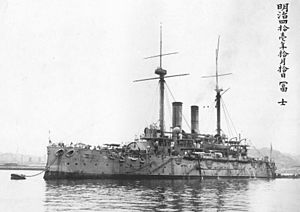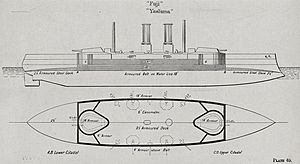Japanese battleship Fuji facts for kids

Fuji at anchor, 1908
|
|
Quick facts for kids History |
|
|---|---|
| Name | Fuji |
| Namesake | Mount Fuji |
| Ordered | 1894 |
| Builder | Thames Iron Works, Blackwall, London |
| Laid down | 1 August 1894 |
| Launched | 31 March 1896 |
| Commissioned | 8 August 1897 |
| Decommissioned | 1923 |
| Reclassified | 1 September 1922 as training hulk and barracks |
| Stricken | 1 September 1922 |
| Fate | Scrapped 1948 |
| General characteristics | |
| Class and type | Fuji-class pre-dreadnought battleship |
| Displacement | 12,230 long tons (12,430 t) (normal) |
| Length | 412 ft (125.6 m) |
| Beam | 73 ft 6 in (22.4 m) |
| Draught | 26 ft 3 in (8.0 m) |
| Installed power | |
| Propulsion | 2 shafts, 2 triple-expansion steam engines |
| Speed | 18 knots (33 km/h; 21 mph) |
| Range | 4,000 nmi (7,400 km; 4,600 mi) at 10 knots (19 km/h; 12 mph) |
| Complement | 650 |
| Armament |
|
| Armour |
|
The Japanese battleship Fuji (named after Mount Fuji) was a powerful warship built for the Imperial Japanese Navy in the 1890s. She was the first ship of her kind for Japan. Fuji was a "pre-dreadnought" battleship, meaning she was built before the more modern dreadnought ships.
Fuji was built in Britain by the Thames Iron Works. She played a big role in the Russo-Japanese War (1904–1905). This included important battles like the Battle of Port Arthur and the Battle of Tsushima. After the war, Fuji became a coastal defence ship in 1910. She then served as a training ship for many years. In 1922, she was turned into a floating barracks and was finally scrapped in 1948.
Contents
Building and Features of Fuji
The Fuji-class ships were the first battleships for the Imperial Japanese Navy. Japan ordered them from Britain because they didn't have the technology to build such large warships themselves. These ships were designed by Philip Watts. They were like smaller versions of Britain's Royal Sovereign-class battleships. However, the Fuji ships were a bit faster and had better armor.
Fuji was about 125.6 meters (412 feet) long. She was 22.4 meters (73 feet 6 inches) wide. Her deepest part in the water was 8 meters (26 feet 3 inches). The ship weighed about 12,533 long tons when fully loaded. She had a crew of 637 officers and sailors.
Engines and Speed
Fuji was powered by two large steam engines. These engines used steam from 10 boilers. They could produce 13,500 horsepower. This power was designed to make the ship go about 18 knots (33 km/h or 21 mph). During her tests, Fuji actually reached a top speed of 18.5 knots. She could carry 1,200 tons of coal. This allowed her to travel about 7,400 kilometers (4,000 nautical miles) at a speed of 10 knots.
Weapons and Armor
Fuji's main weapons were four 305 mm (12-inch) guns. These were placed in two twin gun turrets, one at the front and one at the back of the ship. She also had ten 152 mm (6-inch) quick-firing guns. Four of these were in armored sections on the sides of the ship. Six others were on the upper deck, protected by gun shields.
For defense against smaller, faster ships like torpedo boats, Fuji carried many smaller guns. These included fourteen 47 mm (3-pounder) guns and ten 2.5-pounder Hotchkiss guns. She also had five 457 mm (18-inch) torpedo tubes.
The ship's armor belt was made of Harvey armour. It was between 356 and 457 mm (14 and 18 inches) thick. The armor on her gun turrets was 152 mm (6 inches) thick. Her deck armor was 64 mm (2.5 inches) thick.
Service History and Battles
Fuji was named after the famous Mount Fuji in Japan. She was built as part of Japan's naval plans in 1894. Her construction started on August 1, 1894. She was launched on March 31, 1896, and finished on August 17, 1897. Many Japanese engineers and naval officers, including future Prime Ministers, helped oversee the work. Before sailing to Japan, Fuji took part in a fleet review for Queen Victoria's Diamond Jubilee in Britain in 1897.
In 1901, some of her smaller guns were replaced with more powerful ones. This increased her crew size to 652, and later to 741.
Russo-Japanese War (1904–1905)
At the start of the Russo-Japanese War, Fuji was part of the 1st Fleet. She joined the attack on Russian ships at Port Arthur on February 9, 1904. The Japanese admiral, Tōgō Heihachirō, expected to surprise the Russians. However, the Russians were ready. Fuji was hit by two shells during this battle. Two crew members were killed, and 10 were wounded.
On March 10, Fuji and her sister ship Yashima fired on Port Arthur from a distance. They fired many large shells but did little damage. When they tried again on March 22, Russian shore guns fired back. Fuji was hit by a 12-inch shell and had to pull back.
Fuji was also involved in an action on April 13. Admiral Tōgō managed to lure out some Russian ships. The Russian flagship, the battleship Petropavlovsk, hit a minefield laid by the Japanese. The ship sank quickly, and many sailors, including the Russian commander, died.
Battle of the Yellow Sea
During the Battle of the Yellow Sea in August 1904, Fuji was not hit. The Russian ships focused their fire on the lead Japanese ship, Admiral Tōgō's flagship.
Battle of Tsushima
In May 1905, Fuji fought in the decisive Battle of Tsushima. She was hit about a dozen times. The most serious hit was to the back gun turret. It caused a fire that killed eight men and wounded nine. After the fire was put out, the gun was able to fire again. It is believed that Fuji's gun fired the shot that sank the Russian battleship Borodino.
Later Career
On October 23, 1908, Fuji hosted a dinner for the American Ambassador and officers from the Great White Fleet. This fleet was sailing around the world. In 1910, Fuji's boilers were replaced, and her main guns were updated with Japanese-made ones.
That same year, Fuji was reclassified as a first-class coastal defence ship. She was then used for training duties. She spent all of World War I based at Kure. Her hull continued to be used as a floating barracks and training center until 1945. Fuji was damaged by American aircraft during an attack on Yokosuka on July 18, 1945. She capsized after the war ended. The ship was finally scrapped in 1948.
Images for kids



